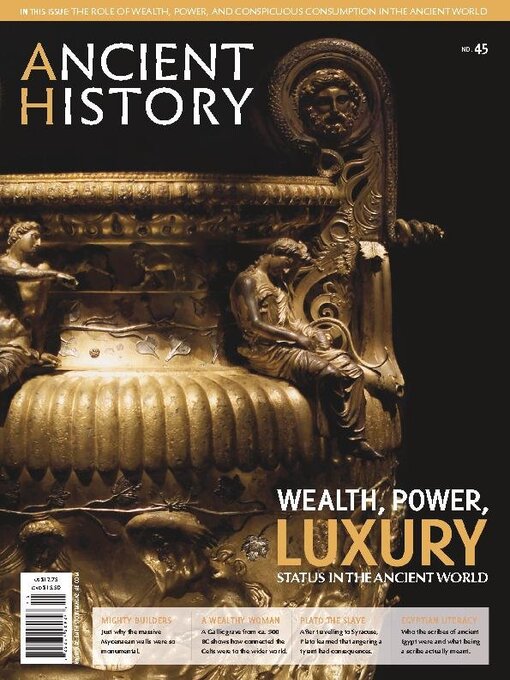Ancient History looks at every aspect of the ancient world: you'll find articles covering politics, society, literature, language, religion, economics, and art - all in one magazine! Like its big brother, Ancient Warfare, Ancient History Magazine is a bi-monthly, 60-page magazine that relies on a thematic approach: each issue is centered around one specific subject. From ancient Egyptian trade and Roman family life to the lost city of Pompeii, there's sure to be something for everyone - all presented in a well-researched but accessible, fun manner.
Ancient History Magazine
PRELIMINARIES
EDITORIAL – ANCIENT EXCESS
Scientists discover the ingredients of a Roman perfume
Hanging by a thread: earliest codex book discovered
Faces of Tartessos see the sunrise again
Getty presents “The Gold Emperor from Aventicum”
A TANTALIZING PROMISE • One of the most spectacular archaeologi- cal discoveries of all ages is the Villa of the Papyri in Herculaneum. The excavators recovered hundreds of ancient scrolls. Unfortunately, they were all burned. That does not mean they are useless, however.
ON THE PAPYRI TRAIL…
TO SCRIBE OR NOT TO SCRIBE • Discussion of occupations in ancient Egypt includes that of the scribe, a person involved in the copying and writing of texts for others, designated by a particular hieroglyphic symbol. However, what actually was ‘scribing' in ancient Egypt, who was a ‘scribe' in this ancient society, and what societal positions did scribes occupy?
THE WOMAN OF VIX • To live in ancient Gaul around the year 500 BC was to live in a world transformed: a vibrant Celtic culture was now in regular contact with early Greek colonies in the south of France and Italy. The river routes of the Rhône and Seine brought luxury goods, technology, ideas, and a humming commercial life to those willing to engage it. The stunning burial of the so-called Woman of Vix is only one story from this time.
CYCLOPEAN FORTIFICATIONS • The size, materials, craftsmanship, and costs of the massive 'Cyclopean' fortifications in the Mycenaean world far exceeded the expectations of warfare at the time. These were acts of conspicuous consumption aimed at projecting and promoting the power and wealth of the ruling elites inside and outside the Mycenaean world.
‘SYBARITIC' ELITES • The Greek polis of Sybaris is synonymous with luxury and decadence, even today. However, the pursuit of wealth was a problem throughout archaic Greece, as elites sought to outdo one another to prove their wealth and power. This competition would often result in civil strife and war, and so states enacted laws to prevent such conspicuous consumption in order to ensure their own survival.
A culture of competition
DECORATING THE ROMAN INDOORS
Pompeiian phases of decoration
THEME THE PRICE OF REMEMBRANCE • Memory had a fundamental importance in Roman culture. Together with the grave monuments destined to house the bodies of the departed, funerary practices offer a fascinating insight not only into the way Romans wanted their identity to be remembered, but also into how established they were financially. In addition, funerary monuments and paraphernalia played a significant role in preserving the memory of wealthy individuals who were often not commemorated by the literary sources.
ROMAN VEGGIES • Romans really appreciated vegetables as an ingredient for both their simple and luxury dishes. Rich and poor ate salads and boiled, roasted, stewed, and fermented vegetables and herbs. A wide variety of greens were available in Rome. Many of these plants were brought to north-western Europe by the Romans in the first century BC. A large selection of ‘new' vegetables became available to the local population, including beet, parsnip, garlic, carrot, fennel, garden cress, dill,...

 AH 52
AH 52
 AH 51
AH 51
 AH 50
AH 50
 AH 49
AH 49
 AH 48
AH 48
 AH 47
AH 47
 AH 46
AH 46
 AH 45
AH 45
 AH 44
AH 44
 AH 43
AH 43
 AH 42
AH 42
 AH 41
AH 41
 AH 40
AH 40
 AH 39
AH 39
 AH 38
AH 38
 AH 37
AH 37
 AH 36
AH 36
 AH 35
AH 35
